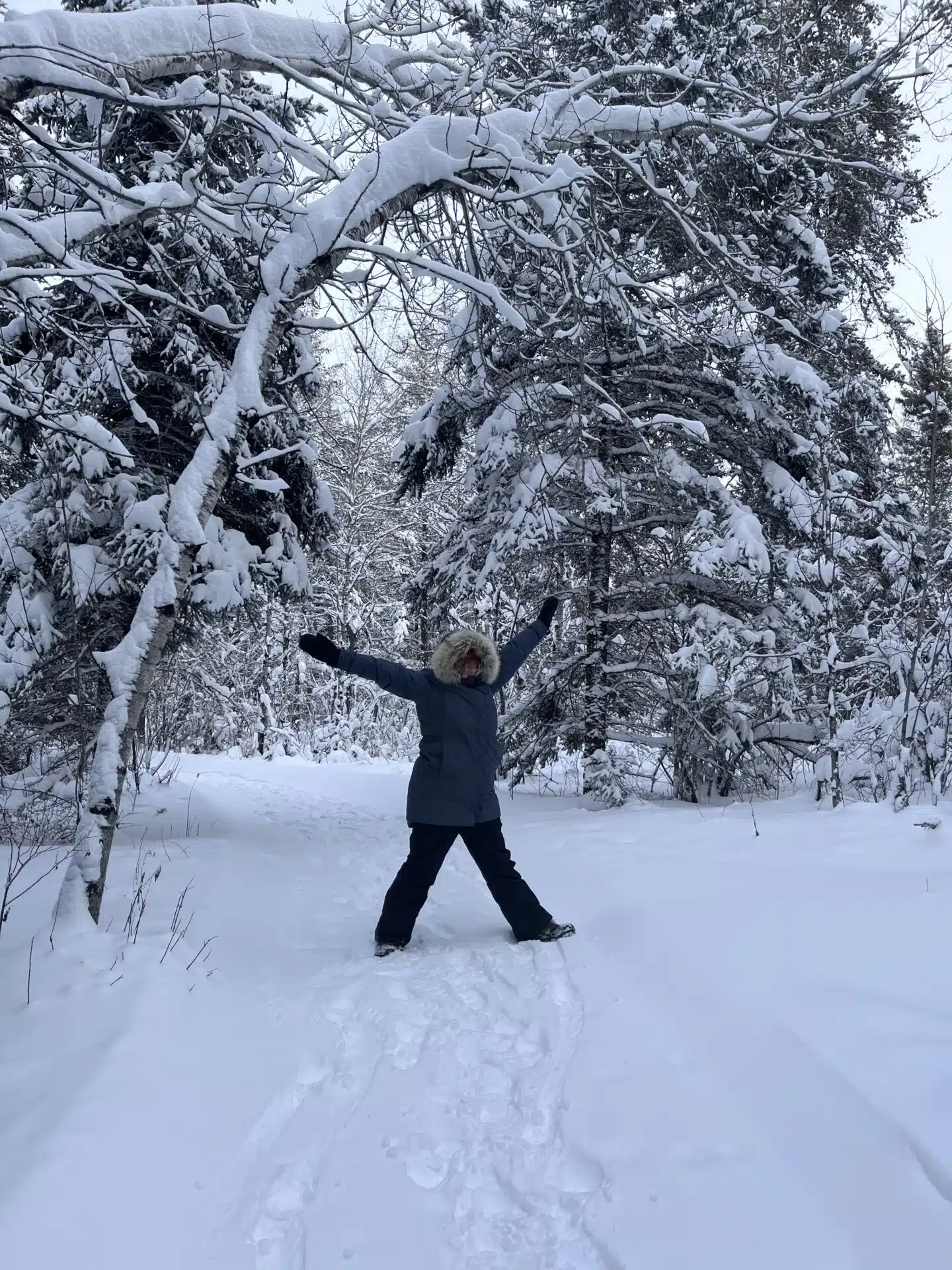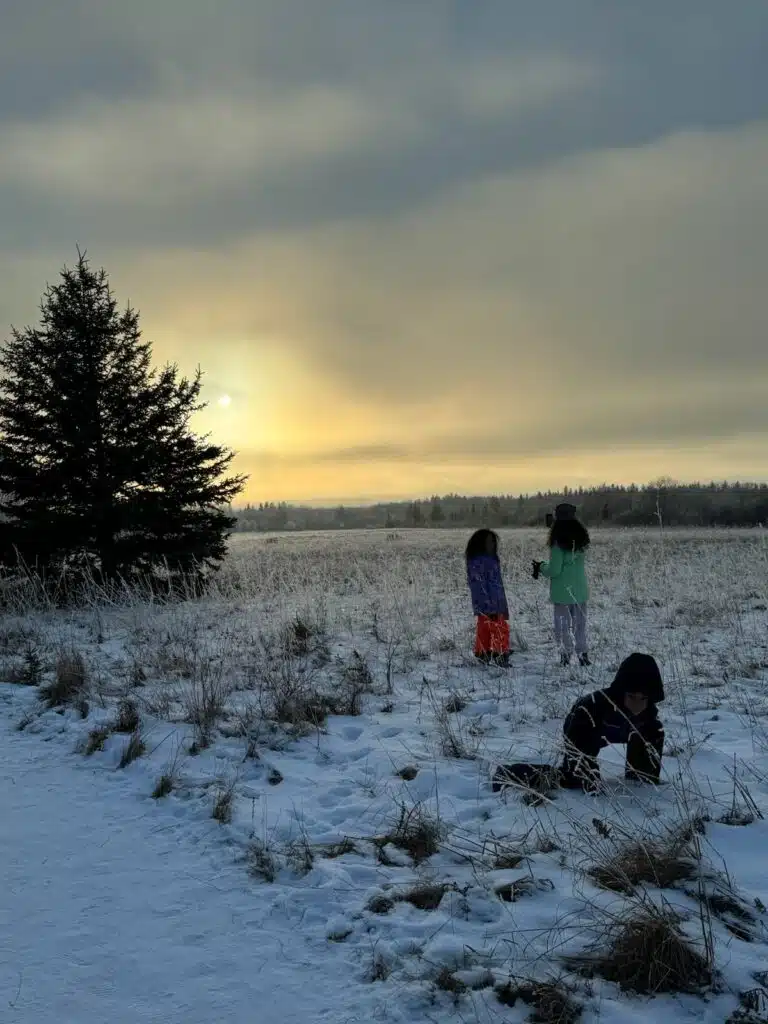
By Mira Oberman, Director of Communications and Public Programs
This article was originally published in the Wolseley Leaf on February 8, 2024.
Most people don’t need a meta-analysis of scientific research to tell them they feel good when they’re out in the woods or listening to waves lapping on the shore of the lake.
But science has come up with some fascinating ways to show how spending time outside improves mental and physical health, sometimes in surprising ways.
Which is why spending more time in nature is at the top of my New Year’s resolution list. And I’m not going to be waiting for spring to do it.
Wandering past the art installations and ice rinks of Wolseley’s Winter Wonderland helps me connect with neighbours and feel part of a creative and generous community.
Cross-country skiing is one of the best low-impact, full-body workouts out there. Perfect for a middle-aged mom like me who’s still working to shed the pandemic pounds.
Nothing quite matches the feeling of strength, vitality and calm I get from hiking in a quiet forest when warm winter sunlight makes the snow sparkle.

Kids by the water are taking a break along Pine Point Trail in the Whiteshell.
Health and Wellness Benefits of Nature
I breathe differently when I’m in true wilderness. So do you! There’s some pretty remarkable science on the benefits of natural sounds — especially when they are free of human-related noise like traffic. Natural soundscapes can reduce stress, lower your heart rate, improve your mood, and even decrease pain.
The Japanese art of forest bathing spawned the new(ish) field of Forest Medicine, which encompasses preventative, environmental and alternative medicines. A 2019 literature review cited improved cognitive performance, drops in blood pressure and increases in levels of cancer-fighting natural killer cells among the demonstrated benefits.
Nature also helps improve sleep, according to a 2019 review of 13 sleep studies.
You don’t need to spend hours in the car to get the benefits of nature (although Manitoba’s beautiful provincial parks are definitely worth the drive.)
Just two hours a week of exposure to nature in parks or home gardens was associated with better health and wellbeing, according to a 2019 study of nearly 20,000 people in the United Kingdom.
Exposure to nature also translated into more community cohesion and substantially lower crime rates, according to a 2015 study of 2,000 people in the United Kingdom.
Healthy forests, lakes and wetlands are working to protect our physical health even when we’re not out in nature. They clean our air, filter our water and act as a protective shield against the worsening impacts of climate change.
Why Children Need More Time in Nature
Connecting to nature is especially important for children, which is why I helped develop an Outdoor Education program at the Manitoba chapter of the Canadian Parks and Wilderness Society (CPAWS.)
Spending time outdoors has been shown to improve academic outcomes in children and alleviate symptoms of attention deficit and hyperactivity disorder (ADHD).
It is also associated with better mental health and enhanced socio-emotional learning like self-awareness, relationship skills and responsible decision-making, according to an extensive research digest by the Children’s Nature Network.

Yet far too many children don’t have regular access to nature.
Instead, an epidemic of excessive screen time is harming kids and teenagers still struggling to recover from the emotional, economic and health impacts of the COVID-19 pandemic.
A third of Canadian youth aged 12-17 spend more than four hours a day on screens on school days and only 27% are meeting guidelines to limit screen time to less than two hours a day, according to a recent study by Statistics Canada.
When it comes to daily exercise, 57% of boys were getting the recommended hour of physical activity in the summer of 2021 (after pandemic restrictions eased following widespread vaccinations.) That’s in line with the before times. Girls didn’t recover from their pandemic slump. Just 35% of Canadian girls aged 12-17 got at least an hour of exercise a day in the summer of 2021, down from 47% in 2018.
Try Nature Once And You’ll Keep Going Back
The wilderness can be a bit scary for people who didn’t grow up tromping through the bush. That’s why I helped develop a Nature Club at CPAWS which lets people check out some of the great hikes near Winnipeg in the comfort and safety of a group of friendly people.
You can also get started with a simple 20-minute walk after work. Or take it up one wee little notch and go for a walk in one of Winnipeg’s lush city parks or Assiniboine Forest.
Dress warmly. Do it mindfully. Think about how you feel before, during and after. You’ll want to do it again. Promise.
Mira Oberman is the director of communications and public programs at the Manitoba chapter of the Canadian Parks and Wilderness Society.
